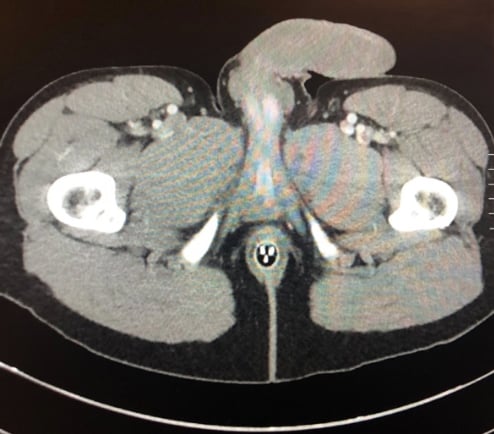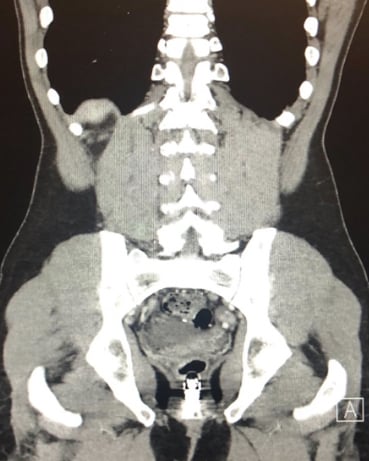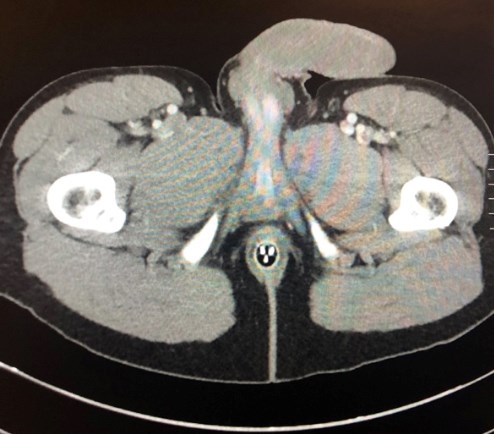Retained foreign bodies are not uncommon in emergency medicine, but this case presented unusual circumstances as the patient had consulted a Reiki master for a regimen of colon cleansing.
Case
A 52-year-old male with a past medical history of deep vein thrombosis on apixaban presented to the ED complaining of lower left quadrant abdominal pain, rectal pain, and a scant amount of bright red blood per rectum. The pain began approximately 1 day prior, shortly after a procedure he called colon hydrotherapy. The patient reported that multiple times over the course of the past year he has sought treatment from a holistic health center due to a health recommendation from his Reiki master. As a regular part of his therapy routine an acupuncturist would insert an aluminum tube into his rectum and spray pressurized water with the intention to improve overall gastrointestinal health. The pain was described as sharp, mostly in the left lower quadrant and rectum. The evening prior he felt the urge to defecate, but the pain was exacerbated upon pushing and he noticed bright red blood on tissue paper when cleaning. He decided to seek care in the morning as his pain was progressively worsening. A CT scan was obtained showing the following images.


Learning Points
A retained rectal foreign body is a complaint that emergency physicians will encounter multiple times throughout their careers. In an urban population-based study, it was found that there is a patient encounter for a retained rectal foreign body at least once per month per hospital. Commonly encountered objects include bottles and glasses (42.2%), but the type of foreign body can vary widely. Patients are more frequently male and the average age at presentation is 44 years old. The reason people insert objects into their rectum is most often autoeroticism, concealment, attention seeking, or reported as accidental insertion. Patients with this presentation are often embarrassed so it is important to respect their privacy. During these patient encounters, providers may want to have a chaperone present at all times due to the psychological nature of this presentation. It is important to remember the potential that the object was placed involuntarily; always ask about the circumstances and offer help or counseling. On initial history taking, as was seen in this case, the patient may not endorse that there is a foreign body in their rectum up to 20% of the time. The most common complaint is abdominal pain, rectal pain, constipation, obstipation, or bright red blood per rectum.
Once the foreign body is discovered through history or imaging, it is vital to repeatedly assess for peritonitis and hemodynamic instability as these situations require emergent surgical intervention. Removal of sharp objects should not be attempted within the ED due to the risk of perforation. If the patient is stable with limited risk factors, transanal extraction can be safely attempted within the emergency department. The patient should be placed in the lithotomy position and receive adequate amounts of analgesia. A perianal nerve block can be used if the object is not easily visualized or palpable. Extraction can proceed while using sufficient lubrication and asking the patient to assist using the Valsalva maneuver. Tools utilized for extraction vary widely depending upon type, shape, and depth of the object. Our first attempt was unsuccessful using a nasal speculum for retraction with ringed forceps to attempt grasping the object. Colorectal surgery was consulted and used special anal retractors with Debakey forceps. Always observe for potential signs of instability secondary to surgical complications following extraction. Obtain a post-retrieval x-ray to rule out potential colorectal injury sustained during the procedure.
Regarding the patient’s colon irrigation, which is also referred to as colon hydrotherapy, or a “colonic,” there is currently no scientific evidence to support its use to promote gastrointestinal health. In contrast, there are serious potential risks. Patients often seek such modes of care in an attempt to cleanse their gastrointestinal system of harmful bacteria, or toxins. The procedure results in the disruption of the normal gastrointestinal flora, which is potentially harmful. There have been numerous case reports displaying the adverse events secondary to colon irrigation, ranging from abdominal pain, vomiting, nausea, diarrhea, bowel perforation, electrolyte imbalance, renal dysfunction, and, as seen in this case, retained rectal foreign bodies. A systematic review published by the American Journal of Gastroenterology in 2009 concluded that there is no evidence to support colon hydrotherapy’s use to promote any form of health and recommended against this modality due to the risks listed above.
Case Resolution
This is not your typical rectal foreign body case, as the structure retained within the rectal cavity is not definitively known, the patient is anticoagulated, and he recently underwent a procedure that is not well known to most medical professionals. The patient was unable to initially tolerate a rectal examination due to the severity of pain. One attempt was made for retrieval after the foreign body was identified on CT scan. The patient was given 100 mcg of fentanyl beforehand to allow inspection, but the foreign body was not able to be visualized. Upon digital insertion, the patient again was unable to tolerate further examination due to pain. Colorectal surgery was consulted and the patient was taken to the operating room where he required high levels of sedation. He was placed in the lithotomy position, underwent sedation, and 2 metal foreign bodies were retracted using Debakey forceps.
References
- Cologne KG, Ault GT. Rectal Foreign Bodies: What is the Current Standard? Clin Colon Rectal Surg. 2012;25(4):214-218.
- Dolgin E. Antidotes edge closer to reversing effects of new blood thinners. Nat Med. 2013;19(3):251.
- Haft JS, Benjamin HB. Foreign bodies in the rectum; some psychosexual aspects. Med Aspects Hum Sex. 1973;7:74-95.
- Gajjar RA, Gupta PB. Foreign body in the rectum: A challenge for the emergency physician. J Family Med Prim Care. 2016;5(2):495-497.
- Acosta RD, Cash BD. Clinical effects of colonic cleansing for general health promotion: a systematic review. Am J Gastroenterol. 2009;104(11):2830-2836.



